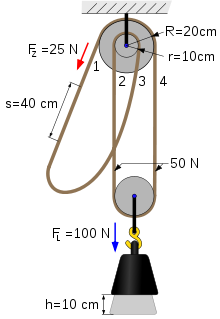- Differential pulley
-
A differential pulley, sometimes called a "chain hoist," or sometimes colloquially called a "chain fall," is used to manually lift very heavy objects like car engines. It is operated by pulling upon the slack section of a continuous chain that wraps around pulleys. The relative sizes of two top pulleys determine the maximum weight that can be lifted by hand.
Mode of operation
A differential pulley can lift very large masses a short distance. The two fixed pulleys at the top (which are attached to each other and rotate together) are of unequal radii, R and r and an endless chain passes around the pulleys and hangs in a loop, as shown in Figure 1. The fixed pulleys are toothed to avoid slippage of the chain.
To illustrate the way it works: if both pulleys at the top are of the same size, a long pull on the chain will raise the section of chain extending down to the lowermost pulley by a similar length to the amount of chain lowered by the other top pulley. The weight will therefore go nowhere. If the top pulleys are of different sizes, however, the ascending section of chain and the descending section will travel by different amounts and the weight will travel also. When the top pulley playing out the descending section of chain is the smaller of the two, more chain rises than falls and the object is lifted. When the sizes of the top pulleys are such that a long pull on the slack portion of the chain raises the weight only by a very small amount, the weight can be considerably larger than a man can lift by himself; an effect that utilizes an engineering phenomenon known as "mechanical advantage". The greater the mechanical advantage, the easier it is to lift an object and the heavier the object that can be lifted.
The difference in radii of the fixed pulleys (R - r) can be made very small, making the mechanical advantage of this pulley system very large.[1][2] Neglecting friction, the mechanical advantage (MA) is MA = 2·R/(R - r).
Notice, as (R - r) approaches zero, MA becomes extremely large, and the movable pulley now rises very slowly, almost no longer rising, even though you are pulling long lengths of chain downward at Fz. Hence, the huge mechanical advantage as r approaches R.
See also
References
- ^ Black, N. Henry, and Harvey N. Davis, Practical physics, fundamental principles and applications to daily life, 2 ed., New York: McMillan, 1922, chapter II, section 34, p. 39.
- ^ United States Naval Education and Training Program Development Center, Basic machines and how they work, New York: Dover Publications, 1994, p. 2-6.
Categories:- Mechanics
- Simple machines
- Mechanisms
Wikimedia Foundation. 2010.

